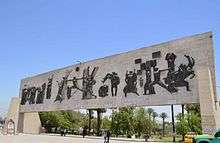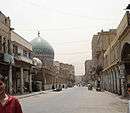Al-Rusafa, Iraq
Al Rusafa (Arabic: الرصافة) or Rasafa a district in of Baghdad, Iraq, on the eastern side of the river Tigris. The west side of the river is Al Karkh. It is one of the old quarters of Baghdad, situated in the heart of the city and his home to a number of public squares housing important monumental artworks.
Description
Rusafa is one of the nine administrative districts in Baghdad. This district is an older area on the eastern side of Baghdad; its central commercial area, a center of markets considered one of the four old central business districts of Baghdad (Karkh, Rusafa, Adhamiyah and Kadhimiya). It includes many urban features which have become landmarks including; Firdos Square and the Liberation Square, the biggest landmark in Baghdad and one of the most visited.

It has also been home to a number of monumental artworks including the; Monument to the Unknown Soldier (1959-2002) designed by local architect, Rifat Chadirji; [1] a statue of Saddam Hussein (2002-2003) by local sculptor, Khalid Ezzat and which was replaced by Freedom by local sculptor, Bassem Hamad al-Dawiri, all located in Firdos Square. [2] The Freedom Monument (Nasb al-Hurriyah), a work by architect, Rifat Chadirji and sculptor, Jawad Saleem is Baghdad's most iconic work, and is situated in Liberation Square.[3] The sculpture of Shahriyar and Scheherazade by sculptor Mohammed Ghani Hikmat situated on the banks of the Tigris River, near Abu Nuwas Street is another example of Iraqi art featured in the area.[4]
Neighbourhoods of Rusafa district include Bab Al-Moatham and Al-Sa'adoon.
References
- Bernhardsson, M.T., "Visions of the Past: Modernizing the Past in 1950s Baghdad," in Sandy Isenstadt and Kishwar Rizvi, Modernism and the Middle East: Architecture and Politics in the Twentieth Century," University of Washington Press, 2008, p.92
- "New Statue Replaces Saddam", BBC News, 30 May, 2003,Online:
- Al-Khalil, S. and Makiya, K., The Monument: Art, Vulgarity, and Responsibility in Iraq, University of California Press, 1991, p. 83
- Al-Khalil, S. and Makiya, K., The Monument: Art, Vulgarity, and Responsibility in Iraq, University of California Press, 1991, p. 74
